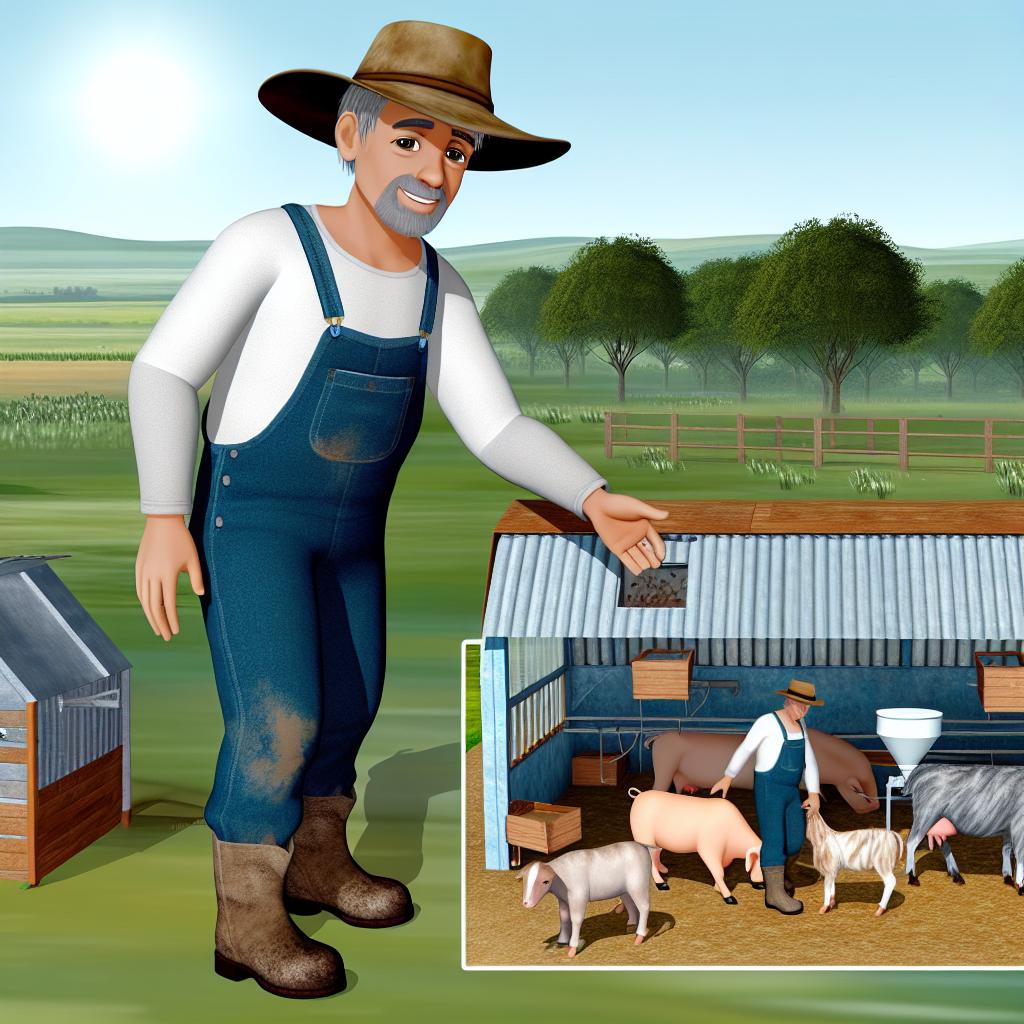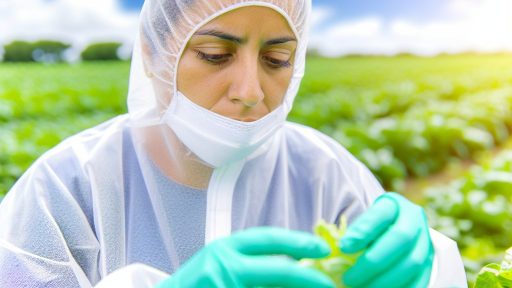Introduction to Animal Welfare
Definition of Animal Welfare
Animal welfare refers to the well-being of animals under human care.
It encompasses their physical and mental health.
Additionally, it includes the animals’ ability to express natural behaviors.
Understanding this concept is vital for responsible farming practices.
Importance of Animal Welfare in Farming
Animal welfare plays a critical role in farm operations.
It impacts the overall productivity of the farm.
Healthy animals produce better quality products.
Moreover, animal welfare significantly affects consumer trust.
Consumers are increasingly concerned about humane treatment of animals.
Legal and Ethical Implications
Legal standards govern animal welfare across many regions.
Compliance with these laws is essential for farmers.
Ethically, farmers bear the responsibility to care for their livestock.
Fulfilling this duty can lead to enhanced reputation and market access.
Benefits of Animal Welfare Compliance
Complying with animal welfare standards offers multiple benefits.
It improves animal health and reduces veterinary costs.
Transform Your Agribusiness
Unlock your farm's potential with expert advice tailored to your needs. Get actionable steps that drive real results.
Get StartedConsequently, better health leads to increased productivity.
Furthermore, welfare compliance enhances product quality.
Consumers are willing to pay more for ethically raised products.
Regulatory Framework
Overview of Animal Welfare Laws
Animal welfare laws protect the rights and well-being of farm animals.
These laws ensure humane treatment throughout the animal’s life cycle.
Different countries have various regulations governing animal welfare.
National guidelines often reflect international standards and best practices.
Farmers must be aware of local, state, and federal laws to maintain compliance.
Compliance Requirements
Compliance with animal welfare laws is crucial for farm operations.
Farmers must adopt practices that align with these regulations.
Regular training programs can help staff understand compliance standards.
Documentation is essential for demonstrating adherence to animal welfare laws.
Farm audits can assess compliance and highlight areas for improvement.
Benefits of Animal Welfare Compliance
Enhancing animal welfare leads to better health outcomes for livestock.
Healthy animals contribute to improved farm productivity and profitability.
Moreover, compliance boosts consumer trust in agricultural practices.
Consumers increasingly prefer products from farms that prioritize animal welfare.
Thus, focusing on compliant practices can enhance market competitiveness.
Assessment of Current Practices
Evaluating Farm Operations Against Welfare Standards
Every farm must assess its current operations critically.
Evaluating against established animal welfare standards is essential.
This evaluation identifies areas for improvement in animal care.
Farmers can use various welfare assessment tools to facilitate this process.
These tools assess facilities, management practices, and animal health.
Additionally, they provide a structured approach to ensure compliance.
Showcase Your Farming Business
Publish your professional farming services profile on our blog for a one-time fee of $200 and reach a dedicated audience of farmers and agribusiness owners.
Publish Your ProfileIdentifying Compliance Gaps
Identifying compliance gaps is necessary for effective improvement.
Farmers can conduct internal audits to reveal these gaps.
Involving a third-party evaluator can provide an unbiased perspective.
Evaluators help ensure compliance with regulations and industry standards.
Common gaps may include inadequate housing and nutrition issues.
Such evaluations focus on animal behavior, health metrics, and facility conditions.
Implementing Changes for Improvement
After identifying gaps, implementing changes is crucial.
You can prioritize improvements based on the severity of issues.
Providing better housing ensures animals have adequate space and comfort.
Enhancing nutrition promotes overall health and well-being.
Regular training for staff improves care practices.
Investing in better equipment also enhances operational efficiency.
Monitoring and Continuous Assessment
Monitoring changes is vital for sustainable animal welfare improvement.
Farmers should establish regular review cycles to assess advancements.
Continuous assessment encompasses daily practices and long-term goals.
Utilizing technology can aid in tracking animal health progress.
Farmers can also benefit from feedback from animal welfare organizations.
Engaging with the community fosters transparency and builds trust.
Gain More Insights: Understanding Food Safety Standards for Modern Farmers
Benefits of Animal Welfare Compliance
Impact on Animal Health
Animal welfare compliance significantly improves animal health on farms.
Healthy animals experience lower stress levels.
This reduction leads to fewer illnesses and better overall well-being.
Moreover, farmers can detect health issues earlier.
This proactive approach prevents complications and ensures animals thrive.
Boosting Productivity
Higher animal welfare standards correlate with increased productivity.
Animals raised in stress-free environments perform better.
For instance, dairy cows produce more milk when well cared for.
Similarly, meat quality improves when animals are healthy and less stressed.
In turn, this boosts profits for farm operators.
Economic Advantages
Investing in animal welfare yields economic benefits for farms.
Lower veterinary costs result from healthier animals.
Additionally, consumers increasingly prefer products from ethical sources.
This preference can lead to higher sales and market prices.
Ultimately, better animal welfare enhances a farm’s reputation.
Explore Further: The Role Of Tariffs In Shaping Agricultural Markets Globally
Consumer Demand: The Role of Animal Welfare in Market Preferences and Branding
Growing Awareness Among Consumers
Consumers today are more informed than ever before.
This new awareness influences their purchasing habits significantly.
As a result, animal welfare has become a critical factor in consumer decision-making.
Many shoppers actively seek products that adhere to ethical standards.
Knowing where their food comes from matters to these consumers.
Showcase Your Farming Business
Publish your professional farming services profile on our blog for a one-time fee of $200 and reach a dedicated audience of farmers and agribusiness owners.
Publish Your ProfileImpact on Brand Reputation
Companies that prioritize animal welfare enjoy a positive brand image.
Effective branding can increase consumer loyalty over time.
A strong commitment to ethical practices attracts conscientious buyers.
Moreover, transparency about animal welfare policies enhances trust.
Market Differentiation Strategies
Brands can stand out by adopting higher animal welfare standards.
Differentiation creates a unique selling proposition in the market.
Some businesses leverage certifications as a marketing tactic.
For instance, organic and humane certifications appeal to ethical consumers.
Consumer Feedback and Adaptation
Feedback from consumers drives continuous improvement in practices.
Companies that listen to customer concerns often see growth opportunities.
Adapting to consumer expectations can enhance product quality.
Ultimately, responsiveness can create a more loyal customer base.
Future Trends in Animal Welfare
As consumer preferences evolve, so will expectations around animal welfare.
Brands will need to stay ahead of emerging trends to remain competitive.
Innovations in farm management could support better welfare practices.
Additionally, collaboration across industries may lead to improved standards.
Gain More Insights: Key Trade Agreements That Influence Modern Farming Practices

Training and Education
Importance of Education for Farm Staff
Investing in education enhances animal welfare standards on farms.
Knowledgeable staff can implement best practices effectively.
Training ensures compliance with regulations and ethical standards.
Creating a Comprehensive Training Program
A well-structured training program includes multiple components.
First, it covers animal handling techniques.
Next, it emphasizes the importance of animal welfare.
Additionally, it integrates compliance with legal standards.
Regular updates to the program keep it relevant.
Utilizing Expert Resources
Farm managers should collaborate with animal welfare experts.
Inviting specialists for workshops enhances knowledge transfer.
Online resources also provide valuable information and tools.
Utilizing scientific literature reinforces best practices.
Encouraging Team Participation
Employee engagement is crucial for a successful training program.
Encourage staff to share insights and experiences.
This approach fosters a culture of learning and improvement.
Moreover, collective problem-solving leads to better practices.
Monitoring and Evaluation
Regular assessment of training effectiveness is essential.
Feedback mechanisms help identify areas for improvement.
Tracking compliance over time shows the impact of training.
Continual evaluation supports ongoing enhancement efforts.
You Might Also Like: Understanding Pesticide Registration Processes
Technological Innovations: Tools and Solutions for Monitoring Animal Welfare
Introduction to Animal Welfare Technology
Technology plays a vital role in enhancing animal welfare standards.
Innovations in this field transform how we monitor and manage animal health.
Showcase Your Farming Business
Publish your professional farming services profile on our blog for a one-time fee of $200 and reach a dedicated audience of farmers and agribusiness owners.
Publish Your ProfileMoreover, they enable farmers to ensure compliance with welfare regulations.
Wearable Technology for Livestock
Wearable devices help track the health and activity of farm animals.
These devices include collars, tags, and sensors designed for specific species.
For instance, cows can wear collars that monitor heart rates and movements.
Such data allows farmers to identify health issues early and reduce stress.
Remote Monitoring Systems
Remote monitoring systems provide real-time data on animal conditions.
These systems use cameras and sensors to monitor environments like barns and pastures.
Farmers can access information on temperature, humidity, and animal behavior.
Consequently, they can make informed decisions to improve animal welfare.
Automated Feeding and Watering Systems
Automated systems streamline feeding and watering processes.
These systems ensure animals receive adequate nutrition and hydration consistently.
Moreover, they reduce human error, enhancing operational efficiency.
Farmers can also monitor consumption patterns, indicating animal health changes.
Data Analytics for Animal Welfare Assessment
Data analytics tools analyze vast amounts of information collected from farms.
This analysis helps identify trends and areas needing improvement.
Farmers can benchmark their practices against industry standards.
Consequently, they enhance their strategies for animal care and compliance.
The Role of Drones in Animal Welfare Monitoring
Drones offer a unique perspective on livestock management on large farms.
They can quickly survey vast areas and monitor herd conditions efficiently.
Furthermore, drones can detect abnormalities in behavior or movement patterns.
This technology promotes proactive measures for animal welfare interventions.
Integration of Technology in Farm Operations
Successful technology integration enhances overall farm management.
It requires training staff and adapting workflows to new tools.
Collaboration with technology providers also ensures proper implementation.
Farmers benefit from continuous improvements and updates in their systems.
Future Directions in Animal Welfare Technologies
The future of animal welfare technology looks promising and innovative.
Emerging technologies like artificial intelligence are on the forefront.
AI can analyze data to predict health issues and optimize care routines.
Moreover, increased public awareness of animal welfare drives technological advancement.
Farmers will continue to adopt new solutions to meet evolving standards.
Case Studies: Successful Implementation of Animal Welfare Programs in Agriculture
Improving Poultry Health at Green Valley Farms
Green Valley Farms adopted a comprehensive animal welfare program.
This initiative focused on enhancing poultry conditions.
Farmers implemented cage-free systems for egg-laying hens.
As a result, hens experienced reduced stress levels.
Moreover, egg production increased by thirty percent.
This success demonstrated the benefits of prioritizing welfare.
Transforming Beef Production at Happy Cattle Ranch
Happy Cattle Ranch revamped its animal husbandry practices.
The ranch focused on pasture-based systems for beef cattle.
It provided ample space and natural grazing opportunities.
This environment led to healthier animals and better meat quality.
Showcase Your Farming Business
Publish your professional farming services profile on our blog for a one-time fee of $200 and reach a dedicated audience of farmers and agribusiness owners.
Publish Your ProfileFurthermore, consumers noted the improved taste and texture.
The ranch reported a significant increase in sales.
Enhancing Dairy Operations at Meadow Creek Dairy
Meadow Creek Dairy prioritized cow comfort and health.
The facility improved housing conditions and nutritional plans.
Cows enjoyed better living environments and more exercise.
As a result, milk production per cow increased substantially.
Additionally, the farm noticed lower veterinary costs.
This program fostered a positive reputation in the community.
Best Practices in Animal Welfare: Shared Insights
- Implement facilities that prioritize animal comfort.
- Provide regular training for farm workers.
- Monitor animal health with veterinary check-ups.
- Incorporate feedback from consumers regarding animal products.
These practices lead to enduring success in agricultural operations.
They enhance community trust and customer loyalty as well.




